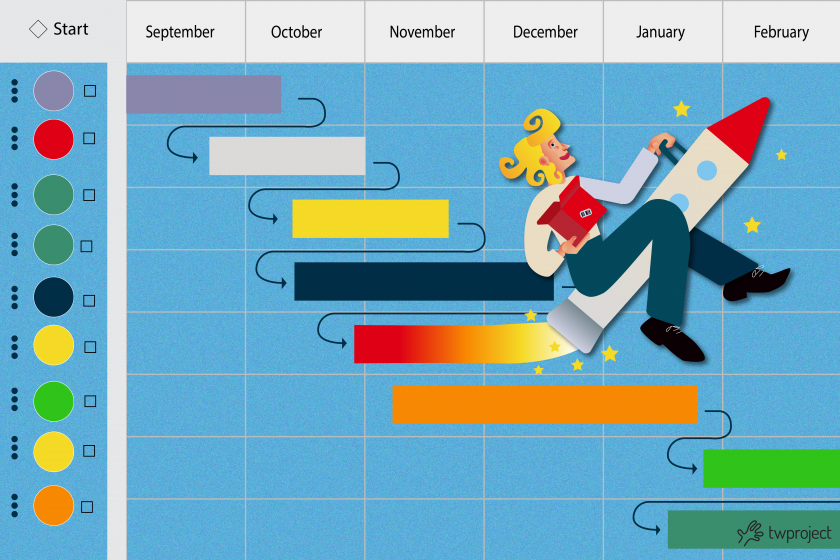-
Twproject free online Gantt service: Save and Share your Gantt charts
Twproject is the state-of-the-art software for the development of a Gantt chart that is easy to build and use but at the same time comprehensive and suitable for every need. TABLE OF CONTENT Integration of Gantt chart and other management resources A further step for comprehensive monitoring 1. Load and operator management 1.1. Allocation of … Continue reading "Twproject free online Gantt service: Save and Share your Gantt charts"
-
Twproject 5.3: drag & drop docs in the browser and more
We just released Twproject 5.3 (build 59500) http://www.twproject.com/download.page There are several new interesting features in the version. Documents and files We introduced drag and drop functionality for uploading files almost everywhere. You can upload your documents on your projects, issues, resources, remote storages in few seconds, even multiple files at once. Duplicated files are versioned for … Continue reading "Twproject 5.3: drag & drop docs in the browser and more"
-
Practical Project Cost Management with Twproject
I had the idea of this post reading an interesting article by Katelyn Anton http://newhiteboard.com/2012/01/18/the-practical-project-cost-management, I warmly suggest you to have a look at it as it is a brief but well structured overview.
-
Teamwork available in Japanese
Teamwork 5.2 now includes a Japanese version of the user interface. We have also published a presentation of Teamwork on the website for Japanese speakers here.
-
jQuery Gantt editor – the code explained
In this blog post, Teamwork’ developer Roberto Bicchierai explains the JavaScript magic behind Teamwork Gantt editor, demo online available here http://gantt.twproject.com. Teamwork version 5 includes it as main project tree editor.
-
Teamwork patch 5.0.1 released
We just released a patch for Teamwork 5, version 5.0.1 (build 53500). Download it here. This patch contains mainly bug fixes: – installations with “non empty context path”, that is, where Teamwork is not running as root application had problems – fixed a bug in setting English or American default settings. – read SVN logs … Continue reading "Teamwork patch 5.0.1 released"
-
Teamwork conceptual evolution leading to version 5
Teamwork’s design and user interface has evolved in time, adapting to the evolution of web based tools and user needs and habits. Version 3. In version 3 Teamwork was a solid and standard web application, before web applications were widely used for management. Version 4. With Version 4 we introduced gamification elements (before they became … Continue reading "Teamwork conceptual evolution leading to version 5"
-
Twproject free online Gantt editor
Twproject’s team in its core developer instance (Roberto Bicchierai) has released a free online service for designing “Gantts” online, here: This editor is a Gantt editor as for functionality, but it actually supports the more extended functionality of Twproject modeling, supporting task state management as distinct from dates management. Supports multi assignments, dependencies, drag&drop, zooming … Continue reading "Twproject free online Gantt editor"
-
Teamwork 4.8 – Plan your issues
With the new Teamwork version 4.8 a new tool for organizing your issues is released. In addition to the issue organizer which lets you change task, assignee, gravity and status simply dragging your issues in different columns, there is now also a new functionality, the issue planner, that helps you schedule issues in time. Here … Continue reading "Teamwork 4.8 – Plan your issues"
-
Adopting project management software: stories of success and failure
In this new video we discuss project management software adoption practices, trying to find patterns of success and failure, drawn from our experience. The video ends with ends with 10 short tips on adopting project management solutions. You can download the “infographic” used (PNG 4.2MB, JPG 3.6MB , PDF 118KB). Transcript I’ve been helping … Continue reading "Adopting project management software: stories of success and failure"
-
Video: a short introduction to Teamwork
We recorded a new short introduction to Teamwork, focused on its functional completeness and rich integrations with other services. Used Prezi for the images, a nice online tool for presentations.
-
Get Teamwork on the cloud
You can now get your own Teamwork server hosted on Amazon cloud: this will be a dedicated server, so you will have all the advantages of having an internal server without having to do any maintenance. E.g. in case of upgrades these will be performed by Teamwork’s staff. For groups of up to 15 users, … Continue reading "Get Teamwork on the cloud"
-
Teamwork 4.7 patch release (4.7.25104)
In this minor release the bug that prevented users deleting Teamwork resources has been resolved. It is a free upgrade for all users of version 4. Get the installer / upgrader here: http://www.twproject.com/download.pag Bug fixed: – Bug that prevents user deleting resources – Iframe portlet not displayed correctly – Loading image on resource profile Small … Continue reading "Teamwork 4.7 patch release (4.7.25104)"
-
Predict the future or improve today
Here is a very short video on predicting the future vs. improving the current situation – which assumes that you know what is happening, who is doing what. The quoted Freakonomics podcast “The Folly of Prediction” is here. Teamwork, with its focus on recording work in very different ways and from different sources … Continue reading "Predict the future or improve today"
-
Get Teamwork support via Twitter
We just published a small update so that Teamwork integrates user help requests to Twitter from inside the application. To do it by hand just tweet @teamworknews.
News
Choose the category you are interested in:
AgileComparisonCost managementPm expertProduct updatesProductivityProject managementResource managementTime managementUsage tips

